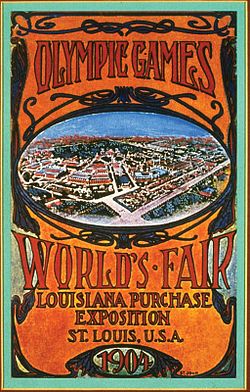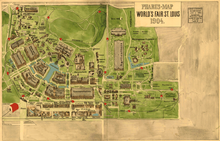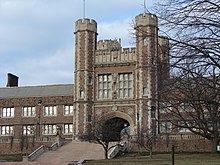Louisiana Purchase Exposition
| Louisiana Purchase Exposition 1904 The Saint Louis World's Fair |
|
|---|---|
 Official program booklet |
|
| General | |
| Exhibition space | 515 ha |
| Number of visitors | 19,694,855 |
| BIE recognition | Yes |
| participation | |
| countries | 63 |
| Place of issue | |
| place | St. Louis |
| terrain |
Forest Park Coordinates: 38 ° 38 ′ 20 ″ N , 90 ° 17 ′ 5 ″ W. |
| calendar | |
| opening | April 30, 1904 |
| closure | December 1, 1904 |
| Chronological order | |
| predecessor | Buffalo 1901 |
| successor | Liege 1905 |
The Louisiana Purchase Exposition (informally also known as The Saint Louis World's Fair ) was a world exhibition held from April 30 to December 1, 1904 in St. Louis , Missouri, USA . The exhibition area in Forest Park was 515 hectares . The exhibition was organized - one year late - to celebrate the 100th anniversary of the Louisiana Purchase in 1803, the sale of the French colony of Louisiana to the United States . The 1904 Summer Olympics were also part of the World Exhibitionwhich were hardly noticed. A total of 19.7 million people visited the exhibition.
procedure
In 1896, Governor David Francis proposed to the St. Louis Businessmen's Association to celebrate the 100th anniversary of the Louisiana Purchase with a major international exhibition. Working groups were formed in 1897 and a preparatory committee was formed in January 1899. In March 1901 the United States Senate approved a grant of five million dollars and the City of St. Louis made the same amount. The construction work began in the summer of 1901. There were considerable delays, which is why the exhibition had to be postponed for a year.
On April 30, 1904, around 200,000 people gathered in front of the entrance to attend the opening. After a speech by Secretary of War William Howard Taft , Governor Francis declared the exhibition open. He sent a radio signal to Washington, DC , where President Theodore Roosevelt activated the electrical generators at the push of a button in the White House .

The 4.9 km² exhibition site, designed by city planner George Kessler (1862–1923), was located in what is now Forest Park and on the adjacent campus of Washington University , around 10 km west of the city center. With over 1500 buildings connected by 120 km of streets and sidewalks, it was the largest exhibition in the world to date. There were 15 specialist exhibitions in “palaces” and exhibition pavilions from 62 states, the federal government and 43 of the 45 US states at the time . The German Empire, for example, was represented with a replica of the Charlottenburg Palace .
Various branches of industry, cities, private organizations and companies, theater groups and music schools were presented. The main attraction was a huge amusement park with an 80-meter-high Ferris wheel that George Washington Gale Ferris had built for the 1893 World's Fair in Chicago. The exhibition also included Völkerschauen , a Hagenbeck circus , replicas of the city of Jerusalem and the Tyrolean Alps as well as a " Filipino reserve" in which "primitive tribes" were exhibited; Another "exhibit" was the pygmy Ota Benga .
Architects
Kessler, who designed numerous city parks in Texas and the Midwest , was responsible for designing the exhibition grounds in Forest Park in St. Louis. In 1901, the organizing committee member responsible for architecture elected Emmanuel Louis Masqueray to be responsible for the design. During his three-year tenure, he designed the Palace of Agriculture , the Palace of Forestry, Fish, and Game , the Cascades , the Colonnades, the Palace of Horticulture ) and the Palace of Transportation .
Many of these buildings served as models for new structures in other cities as part of the City Beautiful movement. Shortly after the exhibition opened, Masqueray resigned after being commissioned by Archbishop John Ireland to build a new cathedral in St. Paul, Minnesota .
building
As with the 1893 World's Fair in Chicago , all of the buildings in the Louisiana Purchase Exposition were temporary, with a few exceptions. The neoclassical exhibition halls were made of a material called “staff”, a mixture of plaster and hemp fibers. As in Chicago, the buildings in St. Louis were exposed to a visible process of decay as the exhibition progressed.
The Palace of Fine Arts , designed by the architect Cass Gilbert , had a large sculpture courtyard modeled on the Baths of Caracalla in Rome . The three-story building on top of Art Hill is now the Saint Louis Art Museum .
The administrative building for the exhibition is now Brookings Hall , a prominent building on the Washington University campus. An exact copy of this building was built at Northwest Missouri State University in Maryville, Missouri, founded in 1905 . The layout of the surrounding gardens also corresponds to the model. The St. Louis Zoo aviary was initially on the exhibition grounds, as was the volcanic statue, the largest cast iron statue in the world, which is now in Birmingham, Alabama .
The Missouri State Exhibition Pavilion was originally intended for permanent use, but the building burned down on November 18, 1904. A reconstruction was not carried out as the exhibition ended almost two weeks later anyway.
The world's largest organ, built by the Los Angeles Art Organ Company, was located in the festival hall. The organ was later put into storage and finally bought in 1909 by John Wanamaker for his Philadelphia department store , where it became famous as the Wanamaker organ .
The Jefferson Memorial Building, completed in 1913, was built next to the main entrance to the exhibit. The building commemorates Thomas Jefferson , who initiated the Louisiana Purchase in 1803. This is where the records and archives of the exhibition were stored. Today the Missouri History Museum is located here .
New foods
Numerous new foods are said to have been invented during the world exhibition. It seems certain that ice cream waffles were presented to the public here for the first time . This claim seems rather dubious in the case of hamburgers , iced tea , cotton candy and peanut butter . However, these foods were presented to the general public during the exhibition and thus became popular. Dr Pepper began selling its caffeinated, carbonated soft drink nationwide here.
Olympic games
The 1904 Olympic Games , the first in the United States, were held as part of the World's Fair . These games were originally given to Chicago . However, when St. Louis threatened to hold a competitive event, these were moved. Nevertheless, as the sporting competitions were spread over several months, there was little interest from the visitors. Because of the high travel costs, many European athletes did not even travel, and neither did Pierre de Coubertin , the founder of the modern Olympic Games.
Miniature train
The Cagney brothers demonstrated a park railway on the exhibition grounds powered by real, scaled down steam locomotives that were heated with coal. They could carry up to 30 passengers - and they weren't just children. Timothy Cagney was named as President and Peter McGarigle as Chief Engineer. They operated the 13 km long miniature railway from April 30 to December 1, 1904 with twenty 4-4-0 locomotives measuring 15 inches (381 mm) and four 4-4-0 locomotives measuring 22 inches (559 mm) Gauge as public transport on the exhibition grounds.
The two routes ran across different areas of the exhibition grounds: A 1.6 km long stretch led outside the Street of Concessions along the Pike . It was next to the granite-paved Lindel Boulevard. Another led on Olympia Way from Skinker Road to Model Indian School . He served the Philippino reservation near the Agricultural Palace.
Reenactment of the Boer War
One of the most popular attractions was the reenactment of the Boer War , which the organizers touted as “the greatest and most realistic military spectacle in world history”. There was a camp of the British army, various villages of the indigenous peoples (including Zulu , San , Swazi and Ndebele ) and an area of 15 acres in which soldiers paraded, sports competitions and horse races were held and battles of the Boer War were re-enacted twice a day.
These re-enactments lasted two to three hours, with the participation of two to three generals and 600 veterans from both warring parties. At the end of the show, General Christiaan De Wet escaped on horseback and jumped ten meters into a pool of water.
Known visitors
John Philip Sousa and his band played on the opening day and on other exhibition days. Tom Turpin hosted a major ragtime competition and Scott Joplin composed the ragtime piece The Cascades especially for the fountains at the World's Fair in the Grand Basin .
President Theodore Roosevelt , who opened the Louisiana Purchase Exposition from afar, did not come to St. Louis until he was re-elected in November 1904, as he said he did not want to use the exhibition for political purposes. Writer Helen Keller , who graduated from Radcliffe College that year , gave a lecture in the main auditorium. Max Weber , a founding father of sociology, attended, along with his wife Marianne , the World Expo and held on September 21, 1904 a lecture on rural communities, he met the painter Max Schlichting , whose work beach fun (Pleasures of the Beach) on the exhibition.
Awards
- Otto Stichling - Large gold medal for two groups of fountains
- Louis Scherf - gold medal in the painting / plate porcelain painter category
- Wilhelm Wandschneider - Gold medal in the sculpture / sculpture category (for bronze sculpture "Coriolan")
- Mollenhauer brothers gold medal for musical instruments (flutes)
- Adolf Hildenbrand bronze medal for the design of a railway lamp
- Hans von Heider, silver medal, porcelain coffee service, Ausf. Buckauer Porzellanmanufaktur
literature
- James Gilbert: Whose Fair? Experience, Memory, and the History of the Great St. Louis Exposition. University of Chicago Press, Chicago IL et al. 2009, ISBN 978-0-226-29310-3 .
- Erik Mattie: World's Fair . Belser, 1998, ISBN 3-7630-2358-5 .
- International exposition St. Louis 1904. Official catalog . Exhibition of the German empire. Publisher Georg Sticke Berlin.
- Marshall Everett: The book of the Fair: the greatest exposition the world has ever seen photographed and explained, a panorama of the St. Louis exposition . Publisher: PW Ziegler, Philadelphia Published, 1904 (In Internet Archive - online)
Web links
- Louisiana Purchase Exposition. Bureau International des Expositions (English). Retrieved March 23, 2017 .
- Missouri History Museum virtual exhibit
- 1904 World's Fair Society
- Illustrated exhibition guide
- Collection of the University of Delaware Library for the 1904 World's Fair
- Official directory of exhibitors
- Louisiana Purchase Exposition: The 1904 St. Louis World's Fair - University of Missouri Columbia - MU Libraries
Individual evidence
- ↑ Replica of Charlottenburg Palace on the exhibition
- ^ All in the Family.
- ↑ Jeff Terry: Lineside Legacy: Preservation on a Smaller Scale.
- ↑ The greatest of expositions completely illustrated. Official publication. Louisiana Purchase Exposition (1904: Saint Louis, Mo.). Publisher: St. Louis, Official photographic company. 1904.
- ^ The street railway review.
- ↑ Stickleback, Otto . In: Hans Vollmer (Hrsg.): General lexicon of fine artists from antiquity to the present . Founded by Ulrich Thieme and Felix Becker . tape 32 : Stephens – Theodotos . EA Seemann, Leipzig 1938, p. 36-37 .
- ↑ Old Masters en miniature - Thuringian porcelain plate painting, writings ... "Otto Ludwig" Museum Eisfeld, B1, 2011
- ^ Mollenhauer recorders: "Company portrait: How it all began ..." ( Memento from December 18, 2014 in the Internet Archive ).
- ↑ Cf. Alexander Missal: Review of: Gilbert, James: Whose Fair? Experience, Memory, and the History of the Great St. Louis Exposition. Chicago 2009. In: H-Soz-u-Kult , March 8, 2010, accessed March 9, 2010.







